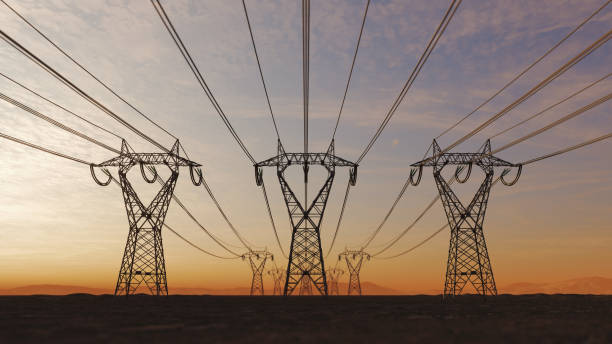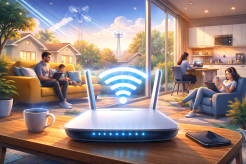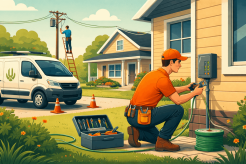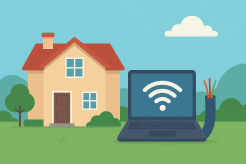What Is Powerline Internet and How Does It Work?

In today’s world of remote work, online learning, and smart home technology, having a reliable internet connection in every corner of your home is more important than ever. While most people rely on Wi-Fi or wired Ethernet connections, there’s another powerful option that many are overlooking — Powerline Internet.
If you’ve been struggling with spotty Wi-Fi in certain rooms or want a more cost-effective alternative to running cables, Powerline Internet might be exactly what you need. Let’s explore how it works, its advantages, and how it stacks up against other networking solutions.
What Is Powerline Internet?
Powerline Internet, also known as Powerline Ethernet, uses your home’s existing electrical wiring to transmit internet signals. Instead of relying solely on Wi-Fi or installing long Ethernet cables through walls and floors, Powerline technology sends data through the same wires that power your outlets.
Here’s how it works:
You plug one Powerline adapter into an outlet near your router and connect it using an Ethernet cable. Then, you plug a second adapter into an outlet in another room where you want internet access. The two adapters communicate over your home's power lines, giving you a wired internet connection without the hassle of new wiring.
Is Powerline Internet Better Than Wi-Fi?
While Wi-Fi is convenient and popular, it has its limitations — especially in large homes or those with thick walls. In contrast, Powerline Internet can offer more consistent performance in areas where Wi-Fi signals typically weaken.
If you’re weighing your options, our comparison on Powerline Internet vs Wi-Fi breaks down both technologies and helps you choose the most cost-effective solution for your household.
Advantages of Using Powerline Internet
1. Easy Setup
Unlike Ethernet wiring or mesh systems that may require complex installation, Powerline adapters are truly plug-and-play. No drilling. No rewiring.
2. Reliable Connection
Because the data travels over a physical medium (your electrical wiring), Powerline Internet is often more stable than Wi-Fi — especially in homes with lots of interference.
3. Cost Efficiency
Installing Powerline adapters can be more affordable than purchasing a mesh Wi-Fi system. If you're curious about internet cost breakdowns and budgeting, check out this guide on data usage and how it impacts your internet plan.
When to Choose Powerline Internet Over Other Solutions
Powerline Internet shines in specific scenarios:
You have poor Wi-Fi coverage in parts of your home.
You’re renting and can’t install new cables.
You need stable internet for work or gaming in a room far from your router.
That said, Powerline technology may not work as well in older homes with outdated electrical wiring or in homes where outlets are on different electrical circuits.
If you're looking into alternatives like Wi-Fi extenders or mesh systems, our detailed article on Wi-Fi extenders and mesh Wi-Fi can help you compare them to Powerline options.
How Fast Is Powerline Internet?
Powerline adapters come in different speeds, typically ranging from 200 Mbps to over 1,000 Mbps. The actual speed depends on:
The quality of your electrical wiring
The distance between the adapters
Electrical noise from other devices on the circuit
It’s ideal for streaming, video conferencing, and even online gaming — though it might not reach the ultra-fast speeds of direct Ethernet cables or fiber optics.
Speaking of wiring, if you're interested in the types of connections behind your internet — from fiber optics to copper broadband technology — it helps to know what infrastructure powers your speed.
Are There Any Downsides to Powerline Networking?
While Powerline Internet is a solid option, it’s not without its flaws:
Performance can degrade if adapters are on separate electrical circuits.
Other electrical appliances (like microwaves or hair dryers) can cause interference.
Some older homes may not support stable Powerline connections.
Still, for most modern homes, these issues are minimal and manageable with quality adapters and proper placement.
Final Thoughts: Is Powerline Internet Right for You?
Powerline Internet offers a unique combination of ease, affordability, and reliability. Whether you're trying to get a solid connection to your home office, gaming setup, or streaming device, it’s a strong contender in the world of home networking.
While Wi-Fi is great for mobility and mesh systems are excellent for large homes, Powerline Internet provides an efficient middle ground — especially if you’re looking for a cost-effective wired internet solution without professional installation.
If you're exploring your options or building a hybrid setup, learning about data usage patterns and different home internet technologies can help you make the most informed decision for your household.
Related Posts

Tue, Dec 16, 2025 2:05 AM
Internet BundlesBest Home Wi‑Fi and Internet Providers in the U.S. (Updated)
Compare the best home Wi‑Fi and internet providers in the U.S., including up‑to‑date pricing, speeds, and coverage for Xfinity, Verizon Fios, AT&T Fiber, CenturyLink, and satellite options.

Tue, Dec 16, 2025 12:26 AM
Broadband InstallationGetting Windstream Fiber Set Up: What the Installation Really Looks Like
Learn what to expect from Windstream fiber installation, from preparation to setup, costs, and optimization tips for faster internet.

Mon, Dec 15, 2025 2:24 AM
Internet Bundles Broadband DealsFrontier Internet Review: Affordable Fiber and DSL
An updated Frontier Internet review covering fiber and DSL plans, current pricing, speeds, fees, and availability. See whether Frontier is worth it for your home.

Mon, Dec 15, 2025 1:11 AM
Internet Bundles Broadband DealsCox Internet Review: Plans, Pricing, and Performance Overview
An updated Cox Internet review covering plans, pricing, speeds, data caps, and fees. See whether Cox is worth the cost.

Fri, Dec 12, 2025 3:17 AM
Internet BundlesHow to Get the Best Value From Your Internet Plan
Learn how to save money on your internet bill by optimizing your plan, upgrading smartly, and choosing the right speed and equipment for your home.